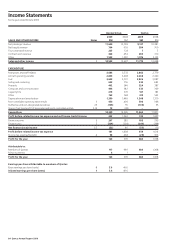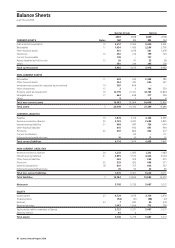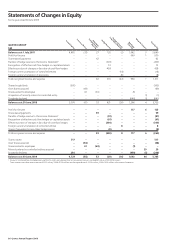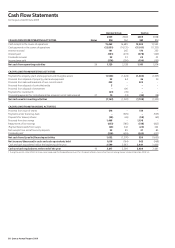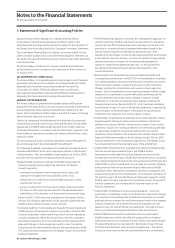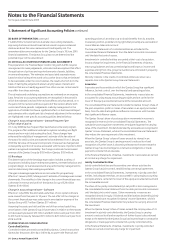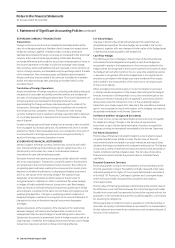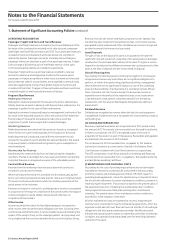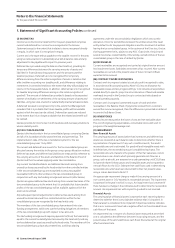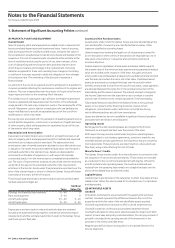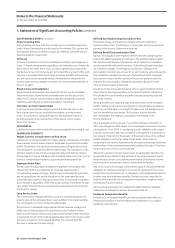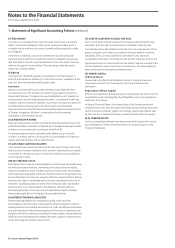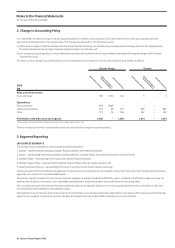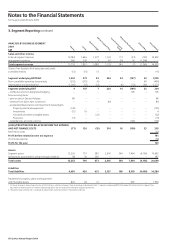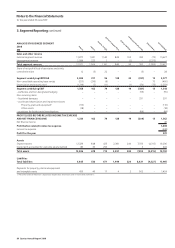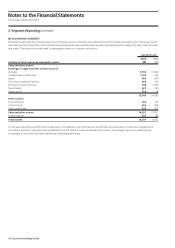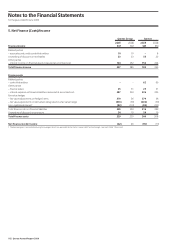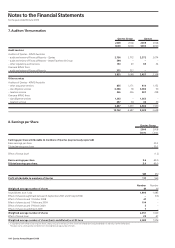Qantas 2009 Annual Report Download - page 96
Download and view the complete annual report
Please find page 96 of the 2009 Qantas annual report below. You can navigate through the pages in the report by either clicking on the pages listed below, or by using the keyword search tool below to find specific information within the annual report.
94 Qantas Annual Report 2009
Notes to the Financial Statements
for the year ended 30 June 2009
1. Statement of Significant Accounting Policies continued
(P) PROPERTY, PLANT AND EQUIPMENT
Owned Assets
Items of property, plant and equipment are stated at cost or deemed cost
less accumulated depreciation and impairment losses. Items of property,
plant and equipment are initially recorded at cost, being the fair value of
the consideration provided plus incidental costs directly attributable to the
acquisition. The cost of acquired assets includes the initial estimate at the
time of installation and during the period of use, when relevant, of the
costs of dismantling and removing the items and restoring the site on
which they are located, and changes in the measurement of existing
liabilities recognised for these costs resulting from changes in the timing
or outflow of resources required to settle the obligation or from changes
in the discount rate. The unwinding of the discount is treated as a
finance charge.
An element of the cost of an acquired aircraft is attributed on acquisition to
its service potential reflecting the maintenance condition of its engines and
airframe. This cost is depreciated over the shorter of the period to the next
major inspection event or the remaining life of the asset.
The standard cost of subsequent major airframe and engine maintenance
checks is capitalised and depreciated over the shorter of the scheduled
usage period to the next major inspection event or the remaining life of the
aircraft. Manpower costs in relation to employees who are dedicated to
major modifications to aircraft are capitalised as part of the cost of the
modification to which they relate.
Borrowing costs associated with the acquisition of qualifying assets such as
aircraft and the acquisition, construction or production of significant items
of other property, plant and equipment are capitalised as part of the cost
of the asset to which they relate.
Depreciation and Amortisation
Depreciation and amortisation are provided on a straight-line basis on all
items of property, plant and equipment except for freehold and leasehold
land which are not depreciated or amortised. The depreciation and
amortisation rates of owned assets are calculated so as to allocate the cost
or valuation of an asset, less any estimated residual value, over the asset’s
estimated useful life to the Qantas Group. Assets are depreciated or
amortised from the date of acquisition or, with respect to internally
constructed assets, from the time an asset is completed and available for
use. The costs of improvements to assets are amortised over the remaining
useful life of the asset or the estimated useful life of the improvement,
whichever is the shorter. Assets under finance lease are amortised over the
term of the relevant lease or, where it is likely the Qantas Group will obtain
ownership of the asset, the life of the asset.
The principal asset depreciation and amortisation periods and estimated
residual value percentages are:
Residual
Years Value (%)
Buildings and leasehold improvements 10 – 40 0
Plant and equipment 3 – 20 0
Aircraft and engines 2.5 – 20 0 – 20
Aircraft spare parts 15 – 20 0 – 20
Depreciation and amortisation rates and residual values are reviewed
annually and reassessed having regard to commercial and technological
developments and the estimated useful life of assets to the Qantas Group
and the long-term fleet plan.
Leased and Hire Purchase Assets
Leased assets under which the Qantas Group assumes substantially all the
risks and benefits of ownership are classified as finance leases. Other
leases are classified as operating leases.
Linked transactions involving the legal form of a lease are accounted for
as one transaction when a series of transactions are negotiated as one or
take place concurrently or in sequence and cannot be understood
economically alone.
Finance leases are capitalised. A lease asset and a lease liability equal to
the present value of the minimum lease payments and guaranteed residual
value are recorded at the inception of the lease. Any gains and losses
arising under sale and leaseback arrangements are deferred and amortised
over the lease term where the sale is not at fair value. Capitalised leased
assets are amortised on a straight-line basis over the period in which
benefits are expected to arise from the use of those assets. Lease payments
are allocated between the reduction in the principal component of the
lease liability and the interest element. The interest element is charged to
the Income Statement over the lease term so as to produce a constant
periodic rate of interest on the remaining balance of the lease liability.
Fully prepaid leases are classified in the Balance Sheet as hire purchase
assets, to recognise that the financing structures impose certain
obligations, commitments and/or restrictions on the Qantas Group,
which differentiate these aircraft from owned assets.
Leases are deemed to be non-cancellable if significant financial penalties
associated with termination are anticipated.
Operating Leases
Rental payments under operating leases are charged to the Income
Statement on a straight-line basis over the period of the lease.
With respect to any premises rented under long-term operating leases,
which are subject to sub-tenancy agreements, provision is made for any
shortfall between primary payments to the head lessor less any recoveries
from sub-tenants. These provisions are determined on a discounted cash
flow basis, using a rate reflecting the cost of funds.
Manufacturers’ Credits
The Qantas Group receives credits from manufacturers in connection with
the acquisition of certain aircraft and engines. These credits are recorded
as a reduction to the cost of the related aircraft and engines. Where the
aircraft are held under operating leases, the credits are deferred and
reduced from the operating lease rentals on a straight-line basis over the
period of the related lease as deferred credits.
Capital Projects
Capital projects are disclosed in the categories to which they relate and are
stated at cost. When the asset is ready for its intended use, it is capitalised
and depreciated.
(Q) INTANGIBLE ASSETS
Goodwill
All business combinations are accounted for by applying the purchase
method. Goodwill represents the difference between the cost of the
acquisition and the fair value of the net identifiable assets acquired.
Goodwill acquired before transition to IFRS is carried at deemed cost.
Goodwill is stated at cost less any accumulated impairment losses.
Goodwill is allocated to CGUs and is tested annually for impairment. With
respect to associates and jointly controlled entities, the carrying amount of
goodwill is included in the carrying amount of the investment in the
associate or the jointly controlled entity.
Negative goodwill arising on an acquisition is recognised directly in the
Income Statement.


